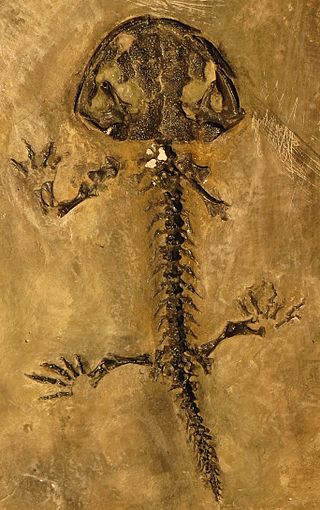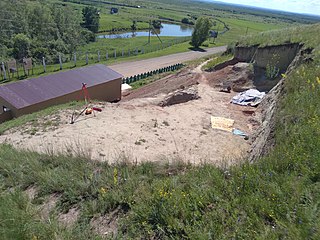
The Caudata are a group of amphibians containing the extant salamanders and all extinct species of amphibians more closely related to salamanders than to frogs. They are typically characterized by a superficially lizard-like appearance, with slender bodies, blunt snouts, short limbs projecting at right angles to the body, and the presence of a tail in both larvae and adults.

Karaurus is an extinct genus of stem-group salamander (Caudata) from the Middle to Late Jurassic (Callovian–Kimmeridgian) Karabastau Formation of Kazakhstan. It is one of the oldest salamanders known.
Lonchognathosaurus is a genus of dsungaripterid pterodactyloid pterosaur from the Albian-age Lower Cretaceous Lianmuqin Formation of Xinjiang, China.

Aralazhdarcho is a genus of azhdarchid pterosaur from the Santonian to the early Campanian stages of the Late Cretaceous period of Bostobe Svita in Kazakhstan. The type and only known species is Aralazhdarcho bostobensis.

The Albanerpetontidae are an extinct family of small amphibians, native to the Northern Hemisphere during the Mesozoic and Cenozoic. The only members of the order Allocaudata, they are thought to be allied with living amphibians belonging to Lissamphibia. Despite a superficially salamander-like bodyform, their anatomy is strongly divergent from modern amphibians in numerous aspects. The fossil record of albanerpetontids spans over 160 million years from the Middle Jurassic to the beginning of the Pleistocene, about 2.13–2 million years ago.
Eoscapherpeton is an extinct genus of giant salamander, known from the Late Cretaceous of Central Asia. Fossils have been found in the Cenomanian aged Khodzhakul Formation and Dzharakuduk Formation, Turonian aged Bissekty Formation and the Coniacian-Santonian aged Aitym Formation of Uzbekistan, the Santonian aged Yalovach Formation of Tajikistan, and the Santonian-lower Campanian aged Bostobe Formation and Campanian aged Darbasa Formation of Kazakhstan.
Kokartus is an extinct genus of prehistoric stem-group salamander (Caudata) from the Middle Jurassic Balabansai Formation of Kyrgyzstan.

Marmorerpeton is an extinct genus of prehistoric stem group-salamanders that lived in Britain during the Bathonian stage of the Middle Jurassic. They are among the oldest known salamanders. Two species were named when the genus was first described by Susan E. Evans et al. in 1988, M. freemani, and M. kermacki, from fragmentary remains found via screenwashing in the Forest Marble Formation of England. Due to the size of their osteocytic lacunae suggesting a large genome size and some morphological characters, like the presence of calcified cartilage in the medulla of its humerus, it was assumed that Marmorerpeton was neotenic. New more complete remains of a new species M. wakei were described in 2022 from the Kilmaluag Formation of the Isle of Skye, Scotland. These conclusively demonstrated that Marmorerpeton was neotenic, and was a member of the family Karauridae, with the other two members of the family, Karaurus and Kokartus being known from the Middle-Late Jurassic of Central Asia. The teeth appear to have been weakly pedicellate.
The Balabansai Formation is a geological formation in Kazakhstan, Kyrgyzstan and Uzbekistan whose strata date back to the Bathonian and Callovian stages of the Middle Jurassic. Dinosaur remains are among the fossils that have been recovered from the formation. The lithology primarily consists of variegated sandstones, siltstones, claystones, and rare gravels and marls. Many taxa have been found in the formation, including amphibians and mammals
The Ialovachsk or Yalovach Formation is a geologic formation in Kyrgyzstan, Tajikistan and Uzbekistan dating to the Santonian age of the Cretaceous period.

Kileskus is a genus of tyrannosauroid dinosaur known from partial remains found in Middle Jurassic Itat Formation of Sharypovsky District, Krasnoyarsk Krai (Russia). Fossils recovered include the holotype maxilla, a premaxilla, a surangular, and a few bones from the hand and foot. Additional remains referred to the species include cervical and caudal vertebrae, as well as a fibula. The skull bones are similar to those of Proceratosaurus. The type species is K. aristotocus. Kileskus was named in 2010 by Averianov and colleagues. Its size has been estimated at 5.2 meters in length and 700 kg in weight.
The Itat Formation is a geologic formation in western Siberia. It was deposited in the Bajocian to Bathonian ages of the Middle Jurassic. Dinosaur remains are among the fossils that have been recovered from the formation, including the proceratosaurid Kileskus, as well as fish, amphibians, mammals and many other vertebrates. The formation is noted for bearing significant coal reserves, with large open pit coal mines extracting lignite from the unit currently in operation.

The Ilek Formation is a Lower Cretaceous geologic formation in Western Siberia. Many different fossils have been recovered from the formation. It overlies the Late Jurassic Tyazhin Formation and underlies the Albian Kiya Formation.
The Moskvoretskaya Formation is a Middle Jurassic geologic formation in the European part of Russia. It consists of continental claystones, siltstones and sandstones deposited in karstified segments of underlying Middle Carboniferous limestone, that would have formed underground aquifers.
Simpsonodon is an extinct genus of docodontan mammaliaform known from the Middle Jurassic of England, Kyrgyzstan and Russia. The type species S. oxfordensis was described from the Kirtlington Mammal Bed and Watton Cliff in the Forest Marble Formation of England. It was named after George Gaylord Simpson, a pioneering mammalologist and contributor to the Modern Evolutionary Synthesis. A second species S. sibiricus is known from the Itat Formation of Russia, and indeterminate species of the genus are also known from the Balabansai Formation in Kyrgyzstan

The Batylykh Formation is a geological formation in Yakutia, Russia. It is of an uncertain Early Cretaceous age, probably dating between the Berriasian and the Barremian. It is the oldest unit of the 1,500 metres (4,900 ft) thick Sangar Series within the Vilyuy syneclise. The mudstones, sandstones and shales of the formation were deposited in a fluvial to lacustrine environment.

Mesochelydia is a clade within Pantestudines, more inclusive than Perichelydia, but less than Testudinata. The clade is known from the Early Jurassic to the Present, and contains all Jurassic representatives of Testudinata aside from Australochelys. The ancestral condition for Mesochelydia is thought to be aquatic, as opposed to terrestrial for Testudinata. They are distinguished from more basal testudinatans by the presence of the following characters: strap like pectoral girdle, supramarginals absent, reduced posterior entoplastral process, eleven pairs of peripherals, elongate processus interfenestralis, paired basioccipital tubercles, fully formed cavum tympani and antrum postoticum, single vomer, confluent external nares, lacrimals and supratemporals absent.

Triassurus is an extinct genus of amphibian, and the oldest member of Caudata. It is known from the Middle to Upper Triassic (Ladinian-Carnian) aged Madygen Formation in Kyrgyzstan. The type species is T. sixtelae.
This list of fossil amphibians described in 2018 is a list of new taxa of fossil amphibians that were described during the year 2018, as well as other significant discoveries and events related to amphibian paleontology that occurred in 2018.
This list of fossil amphibians described in 2020 is a list of new taxa of fossil amphibians that were described during the year 2020, as well as other significant discoveries and events related to amphibian paleontology that occurred in 2020.











